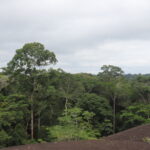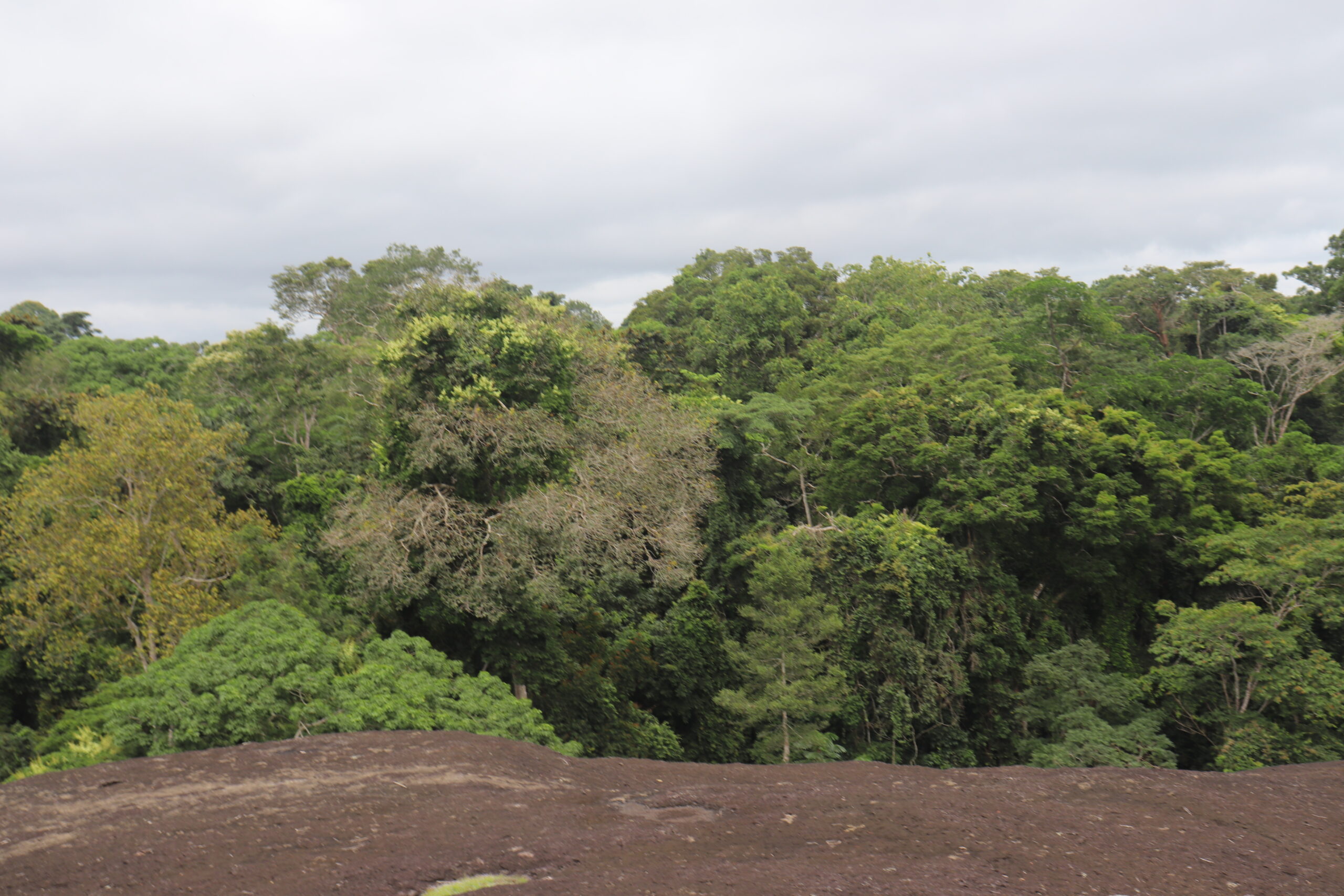Interviewed by Leocadia Bongben
Protection and conservation of the 1,3 m ha. of the Dja Biosphere faced with menace from poaching and intrusion remain daunting for management. The good news is that the elephant, chimpanzee, and gorilla populations are increasing. The Dja Biosphere has three layers: the Wildlife Reserve, 526000 ha; the transition zone, 740000 ha; and the buffer zone, 62000 ha. The Dja Biosphere is in a forested area on the border with Congo, to the southeast of Cameroon, between the East and South regions. The biosphere has four entry points: north, east, west, and south. Gilbert Oum Ndjock, Dja Biosphere Conservator, spoke to journalists about the state of the Dja Biosphere during a visit to Somalomou, organized by UNESCO.
Excerpts:
Cameroon Factfinder: Tell us how you manage the Dja Biosphere daily.
Gilbert Oum Ndjock: Since it’s International Environment Day, we will focus on the biosphere reserve. Let’s say, concretely, that the conservator’s work is coordination. There are different units of the biosphere reserve. An antenna in the north is the main entrance to the biosphere reserve in Somalomou. Other units are in Lomie in the east and Djoum in the south; in the west is Meyomassala. It’s four sites that respect the four geographic points of the biosphere. These units have representations of the coordinating services. All the teams work in the same pattern, having antenna leaders, unit leaders, and flight leaders. The conservator ensures coordination and visits the units once a month. Every quarter, we meet in internal coordination meetings to share data with the entire coordination team and ensure that each antenna is aware of activities in other units. To enable the teams to share their experience or to level up with antenna-going activities, At the end of the year, we meet with the partners for an efficiency evaluation of the reserve management and go through our annual work plan. We examine each section to evaluate the implementation of the activities planned at the beginning of the year. With the support of partners and government commitment, the exercise provides the opportunity to try to meet the requirements of management and the principles of UNESCO through these two entities: the wildlife reserve and the biosphere reserve.
Can we have an example of planning in 2023 and the outcome?
In 2023, we plan a minimum of 2 patrols per month per unit. So we had 2 patrols per month for 4 antennas: eight patrols, and on average, 96 patrols per year. I can assure you that they are 100% realized. Besides patrolling forests, biomonitoring—the state of the habitat—is carried out to ensure the forest has not been impacted by human activity. We completed that activity by following animal tracks with the naked eye, through the pedestrian patrols that are carried out, and checking the camera traps spread throughout the forest to consider the effectiveness of the presence of a certain number of animals. Twenty patrols were planned last year and realized at 100 percent. The third is monitoring facilities in the forest, such as frontline posts and the research station. The distant post requires monthly monitoring and a permanent stay at the research station to prevent intruders from destroying these facilities. Be it monitoring or protection patrols, ecological or facility monitoring inside the forest, or planned activities at the beginning of the year, they were carried out close to 100 percent.
What has been the impact, positive or negative, of the activities carried out?
Looking at the government’s commitment to increasing human resources, we can tell you that none of our facilities have been degraded and local communities have not illegally occupied the reserve. Going by the results and the reference inventory of 2018 and the control inventory of 2021, there is a slight increase in the population of gorillas (2756 individuals in 2021 against 2785 in 2018) and chimpanzees (2141 individuals in 2021 against 2050 in 2018), for example, and a stabilization in the population of elephants (225 individuals in 2021 against 219 in 2018), which are the main targets of conservation. It is possible to increase our investment in this regard again to continue to guarantee the integrity of our facilities.
Did you observe any species disappearing?
We are considering another inventory between the end of 2024 and 2025 to confirm the results of the two previous inventories. For the moment, based on the photo that we have of our reserve, the results are rather encouraging. We can say that no particular species is threatened. I insist that our main conservation targets, which are elephants, gorillas, and chimpanzees, have populations that are rather reassuring, and this is the result of the multiplication of the efforts that have been made.
Each effort has a cost. Can you evaluate the cost?
If we make a small assessment of the anti-poaching patrols, our expenditure is around FCFA 10 million for surveillance patrols. That is to say, for the four antennas, our financial needs stand at FCFA 10 million. In addition to monitoring our infrastructure, ecological monitoring, and the placement and replacement of camera traps, we need around FCFA 15–16 million per month. Fortunately, the state and its partners have judged it necessary to continue mobilizing finances to ensure a permanent presence on the ground. As for the other activities that lead to eroding the borders around the reserve, the partners are at this precise moment increasing the capacity of the equipment, especially vehicles and motorcycles. There will be an official launch ceremony for the new support program for the Dja Biosphere Reserve, and the partners will mobilize resources.
When will the program be launched?
The program launch is imminent. I am telling you that at the moment there is an acquisition of all kinds of equipment—technical, rolling, individual, or collective. At this precise moment, the partners are purchasing this material, and therefore it will only be made available through the solemn launch of the new initiative to support the Dja Biosphere Reserve
Is there any unit that causes a problem?
For me, all of the units are of equal importance. We can encounter difficulties because the old material has not been renewed or replaced. You can have a patrol team of ten with fewer motorcycles. In terms of threats, for example, we have pockets of intrusion, like between the north in Somalomo and the west antenna, especially between Somalomo and Bengbis. This is a problematic area. This is one of the areas where we have increased patrols. This area plays an important role in fighting the poaching we encounter on the ground. There is a second area in the southeast part of the reserve because of the fauna corridor of transhumance. Poachers are aware that it is a place where they will usually wait for the passage of animals to poach. So, this is also one of the places where we mobilize the maximum number of personnel between Mintom and Lomie.
You said that the reserve is under surveillance and that it is necessary to provide information. When will this stop?
We can call it surveillance, but let’s say UNESCO monitoring is not an introspection into the affairs of managers. We need outsiders who look at us and give us the necessary advice. and experiences of other sites with similar UNESCO interests. It is adopting the same methods as other sites to improve capacity and reduce the problems encountered. At one point, we were threatened with registration on the red list of endangered sites, but in the meantime, our efforts have changed the situation. Cameroon was obliged to produce reports annually to present what had been done as an investment to improve site management. We have demonstrated our capacity for improvement by putting resources and changing our way of doing things on the ground. That is why today we are more of an under-observation site than a threatened site. We are in a period of observation and exchange of information between UNESCO and the State Party. We have returned to the normal periodicity for the reports on the state of conservation that we present every two years. This means we are gaining trust through our results and those of the independent observers working in collaboration to reverse the situation at the site.



